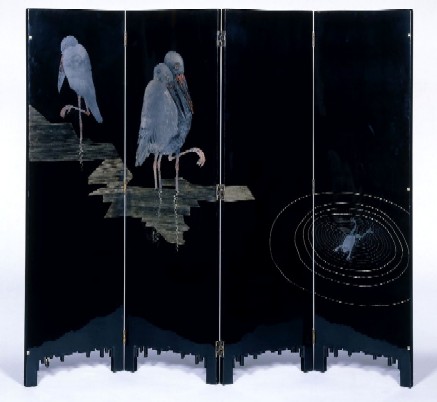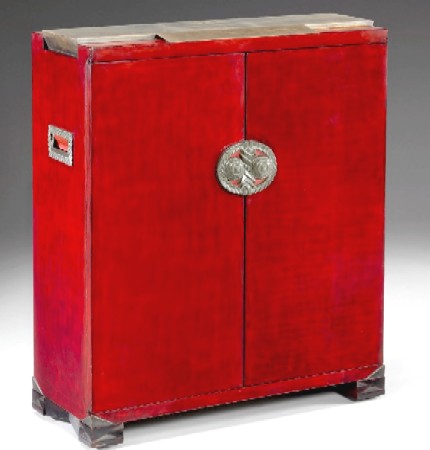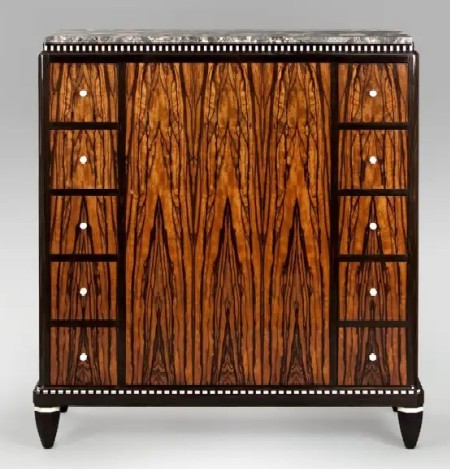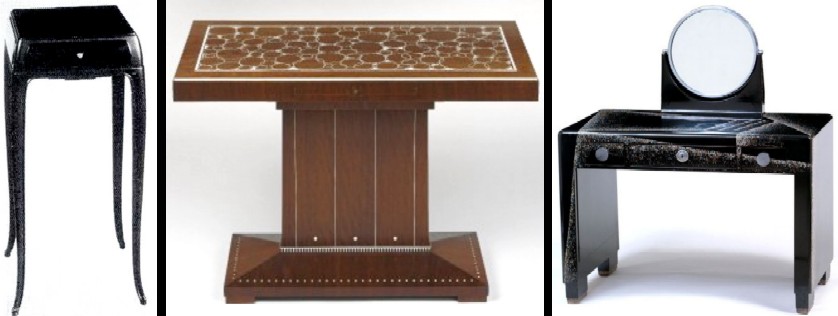
Asian Influence in Art Deco and Streamline Moderne
"Unlike the Chinoiserie movement of the 17th and 18th centuries, where European designers created a fanciful mix of exotic elements without an in-depth understanding of Asian cultures, Art Deco designers in the early 20th century had a profound knowledge of Asia and China. This was facilitated by numerous exhibitions on Chinese art held

Screen with Herons and Frog, Black Lacquer on Wood with Silver,
Pink and Gold Lacquers, Jean Dunand, c. 1927, Pinterest
in France and the accessibility of museum collections, notably the Musée Guimet, which opened in Paris in 1889. The exposure to authentic Chinese art and artifacts provided Art Deco designers with a rich source of inspiration and a genuine appreciation for the intricacies of Asian aesthetics, leading to more culturally informed and authentic designs." (rugandkilim.com)
While some Art Deco and Streamline Moderne pieces still embraced the highly Westernized Chinoiserie designs, other artists were more serious in their pursuit of the Asian influence. A prime example of this was Jean Dunand's extended education in the correct method for applying lacquer in the traditional Japanese style. So let's consider the ways in which some of the artists in the Western world during this period incorporated Asian artistic influences into their work. For this, we turn to Jennifer L. Maata, author of the article "Japanese and Chinese Influences on Art Deco", found in Athanor XVIII (2000).
Maata identifies three influences which encouraged French artists in the interwar period to use Asian designs in their work. The first were the Asian aspects found in previous popular design styles, particularly Art Nouveau. The second was the popularity of the Ballets Russes in Paris in 1906. "Almost over night, the highly coloristic and sensual vein of the East identified with the Ballets Russes became decorative and fashion commodities. The ballet used Chinese characters as well as costumes and sets in Chinese styles." (Maatta, p. 63) The third influence resulted from an influx of Asian goods after World War I. The last two ignited popular interest in reflecting more genuine Asian designs.
She goes on to point out that because artists producing Art Deco style designs in the 1920s were working for wealthy clients, it was important not to simply reproduce Asian designs "since their clients could afford the originals." Instead, they used the forms and motifs found in original Asian art. They also sought to distance their use of Asian designs from the fanciful Asian-influenced Art Nouveau designs. "Art Deco approaches Oriental influences from different angles and in a new light from what had been done in preceding Western styles." (Maatta, p. 63)
French artist Jean Dunand was a master at bringing Asian influence into Art Deco pieces. 
Financial Document Cabinet for Jacques Doucet, Lacquered Wood, Pewter
and Bronze Fittings, Pierre Legrain and Jean Dunand, French,
Virginia Museum of Fine Arts
He showed other design artists techniques which they incorporated into their own works. Dunand borrowed from Japanese and Chinese art as well as combining their ideas and techniques in new ways. "In that sense alone the furniture is original. In addition, he combined Oriental elements in conjunction with various Occidental elements. This mesh of East and West led to a varying degree of direct Oriental influences within each piece. Dunand brought Oriental art elements to the awareness of other artists of the Société, and from there the influence spread. Ultimately, the concepts and principles he learned and practiced became popular among Art Deco artists in general." (Maatta, p. 64)
Maatta highlights a number of Art Deco pieces executed in the Asian styles, providing details about their design and techniques used to make them. The first is seen above left, Dunand's Screen with Herons and Frog. Maata explains,
"Other than being simply a natural scene, the heron, in particular, is a common Chinese motif. It can be seen in a screen dated 1691. In the Chinese screen the herons peck at mushrooms under pine trees; in the sky are stylized clouds. While the Chinese screen is covered by the picture, Dunand pared his scene down to 3 birds and a frog, thus leaving negative space and simple lines to distinguish land from water. Dunand’s screen incorporates multiple Oriental elements including the screen form itself, the lacquer technique, and the subject matter, yet is distinctively original in his use of space." (Maatta, p. 64)
The second piece is the Financial Document Cabinet which Pierre Legrain and Jean Dunand created for Jacques Doucet, seen above right. Of this, Maata says,
"Executed in a bright red lacquer, the cabinet has two doors that close by means of a pivoting pewter lock in a stylized floral design. The interior is comprised of twenty-four small file drawers in a lighter red lacquer. ...the cabinet resembles a Japanese functionary chest. Functionary chests were a special kind of ledger chest in which important documents of feudal domains and local officials were kept. Although functionary chests vary considerably in style, the basic design generally has a square front, double doors opening to multiple drawers, and heavy metal fittings. Clearly, the technique and design of Legrain’s cabinet are Japanese. However, the metal fittings on Legrain’s cabinet are not as extensive or elaborate as those typically found on Japanese chests. In fact, they are not Oriental in style. Though the primary elements which make up the cabinet— its shape, doors, and general disposition of the drawers—are Japanese, some of the smaller details such as the stylized design of the metal work and the addition of metal feet give it away as a Western chest." (Maatta, p. 64)

Cabinet, Brèche Orientale de Baixas Marble, Macassar with Ivory and
Ebony,Molding, Léon Jallot, c1925, 1st Dibs.
The cabinet at left was designed by French artist Léon Jallot. Maata's description says, "Art Deco artists also imported Asiatic woods. The amboyna and macassar ebony were often used. Extensively used by Ruhlmann, these exotic woods became diffused through the Art Deco community as can be seen in a cabinet by Jallot." (Maatta, p. 65)
The remaining three pieces seen below include a bedside table, a large table and a vanity. All are decorated in lacquer. Beginning with the bedside table, Maata notes,
"The design of these black-lacquered tables resembles a style used by the Chinese for a variety of small tables and stools, an example of which can be seen in the Ming dynasty (1368-1644) stool. Paradoxically, the Chinese borrowed the cabriole leg from the West. Apparently, Dunand simplified the form, elongated the legs, and excluded the stretchers from them. In this way, he returned to the West the cabriole legs but retained the Chinese character in these bedside tables." (Maatta, p. 64)
Of the table, she explains,
"Inlaid materials were commonly used by Japanese and Chinese furniture designers; they used many semi-precious materials including mother-of-pearl, carnelian, jade, ivory, quartz, lapis lazuli, agate, turquoise, and coral. ...ivory was the most popular inlay adopted by Art Deco artists. Used extensively by [Emile-Jacques] Ruhlmann, fluted ivory ribs, ivory feet, key plates or handles, or simple whorl or circle patterns of ivory dots set flush within the surface gave his furniture its single touch of contrast other than the veneers he used." (Maatta, p. 65)
Finally, regarding the splendid vanity below which showcases some of Jean Dunand's innovative lacquering techniques, Matta says,
"[Japanese and Chinese furniture designers] began using exotic materials [as inlays] from all over the world including inlays and woods from the Far East. Dunand revived the spectacular Oriental technique of inlaying particles of crushed eggshells. This method had already been used by the Japanese to highlight decorative details on sword-hilts and scabbards, but there is absolutely no doubt that Dunand was the first to use eggshell to cover large surfaces and to create white areas which could not be achieved with natural lacquers. ...Dunand ....employed crushed eggshells on the dressing table designed by Ruhlmann. The effect achieved was that of a minute crazy-paving, each piece of eggshell set in by hand and separated by a hair’s-breadth thread of lacquer." (Maatta, p. 65)
Original Facebook Group Posting

Asian Influenced Furniture, from left - Bedside Tables, Black and Red Lacquer, Jean Dunand, 1921, Design Gallerist; Table, Amaranth Veneer on Mahogany and Oak with Ivory Inlay, Ivory Dots on Base, Jacques-Emile Ruhlmann, c. 1923, Brooklyn Museum; Vanity, Black Lacquer with Inlaid Eggshells, Jacques-Emile Ruhlman and Jean Dunand, 1927, Pinterest.